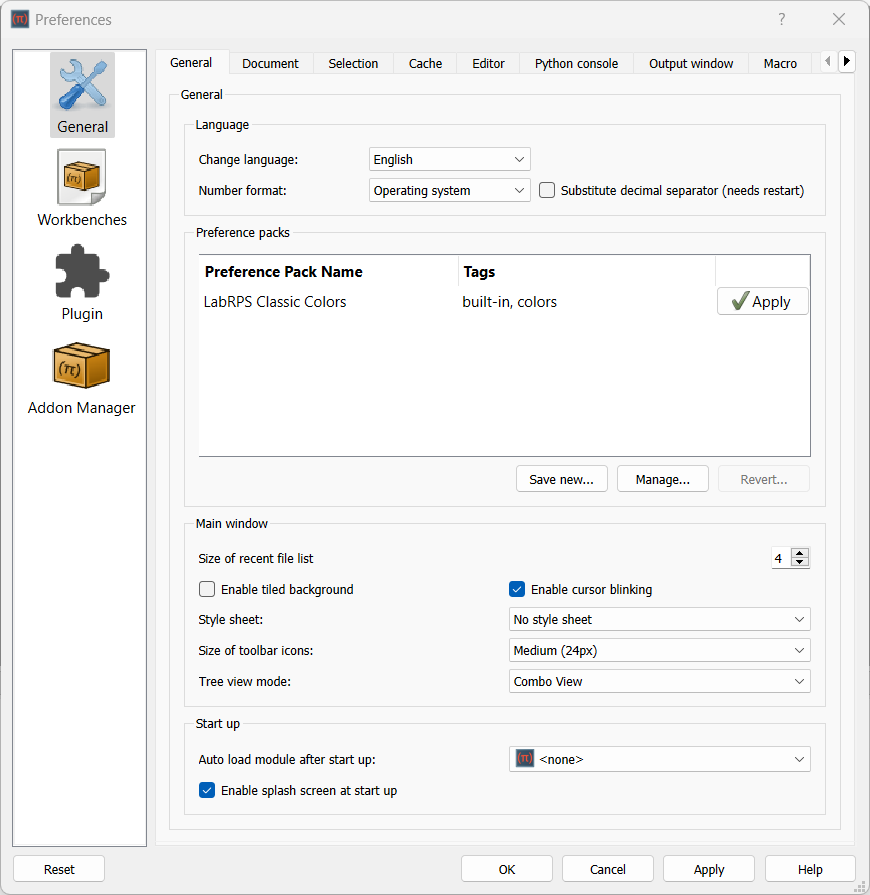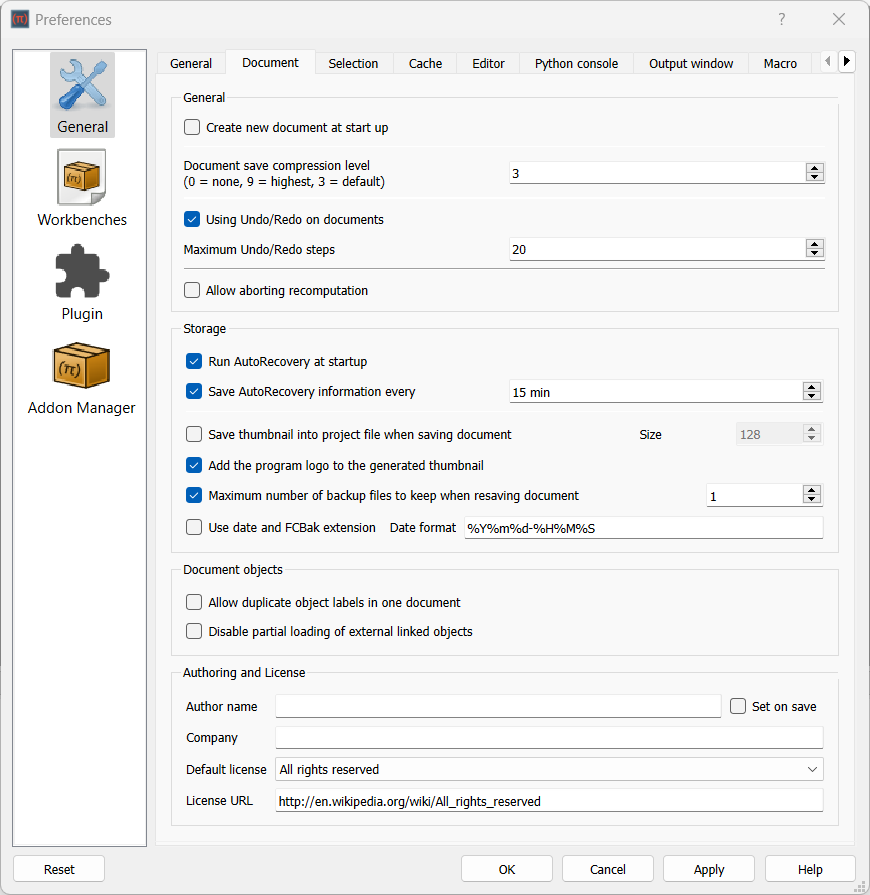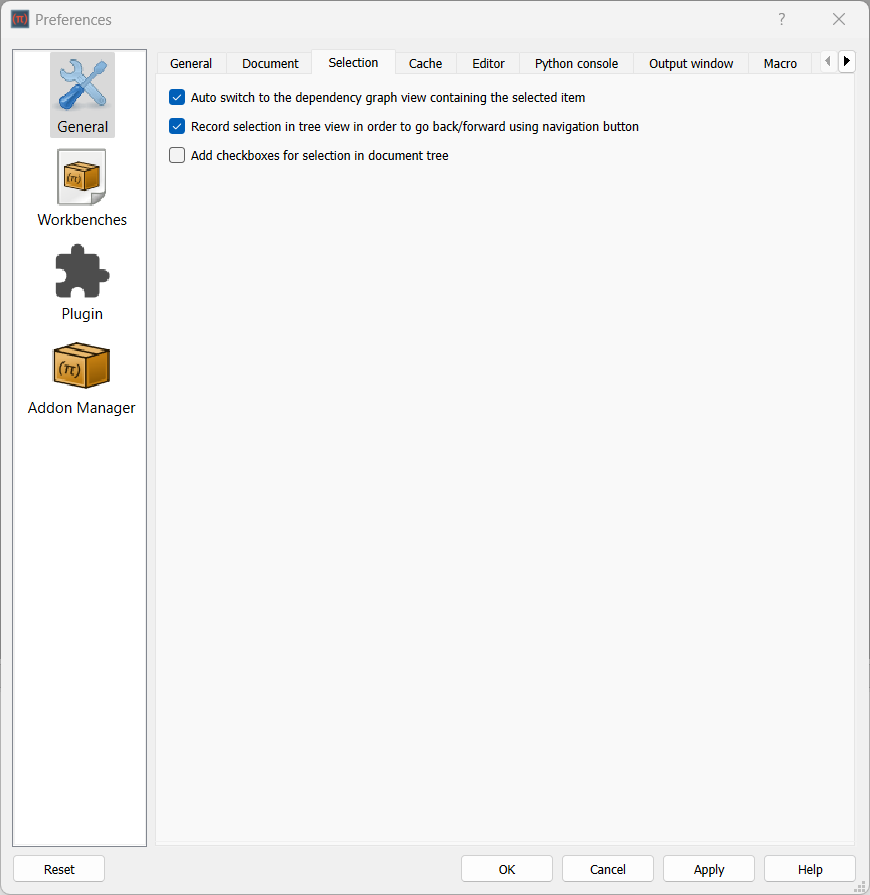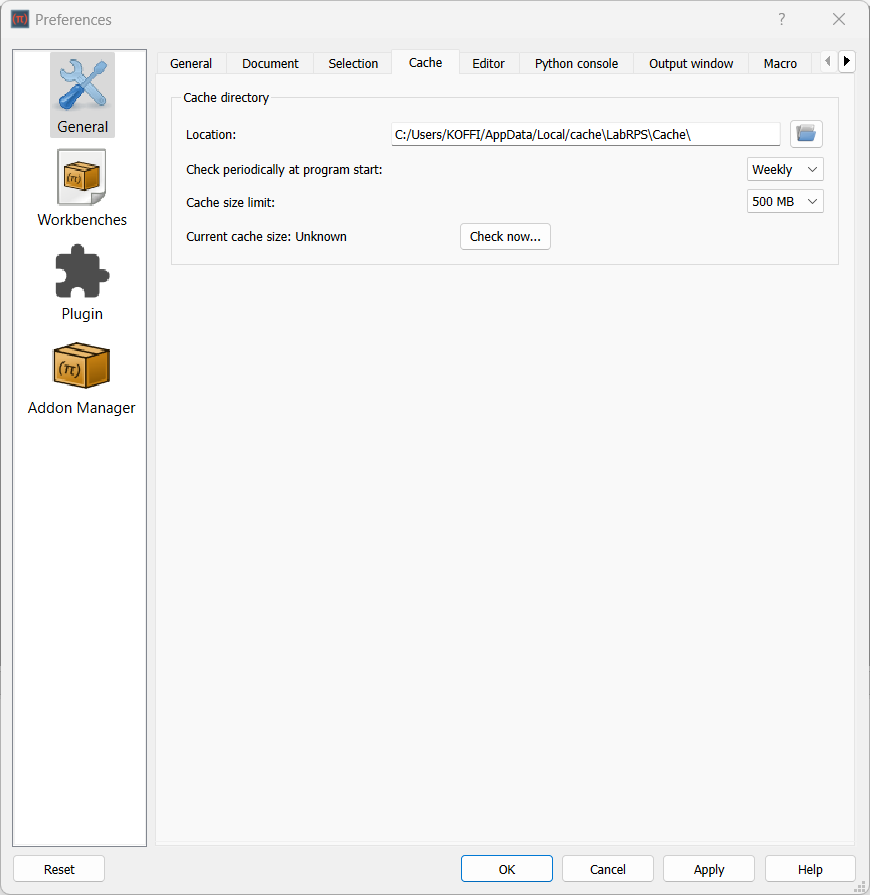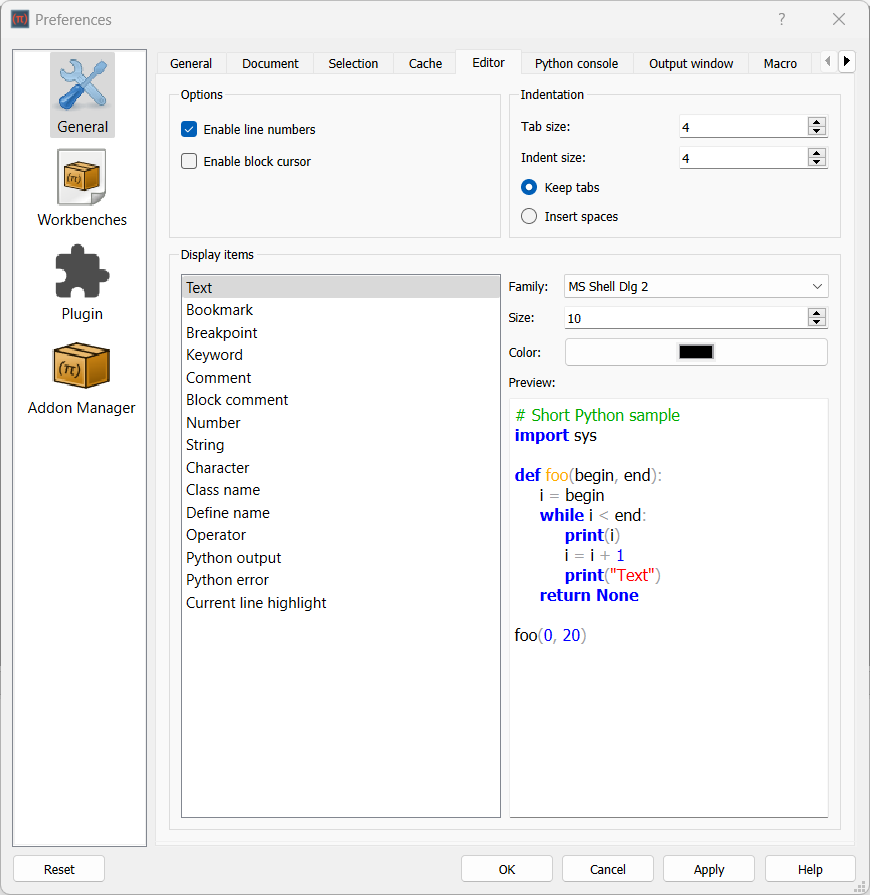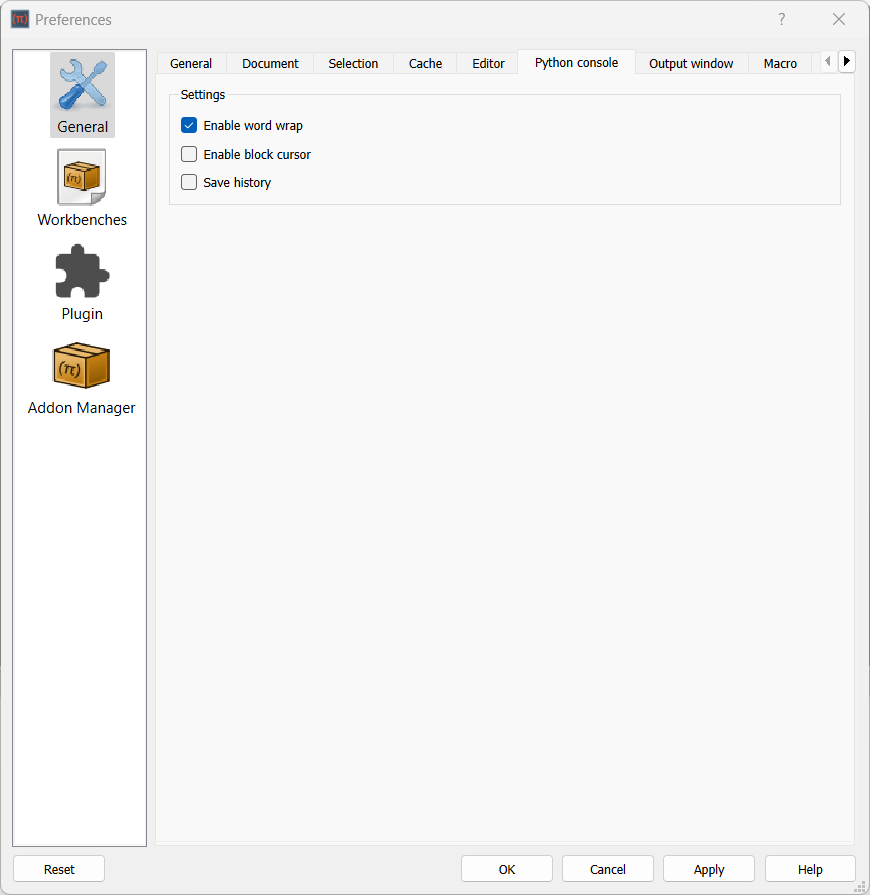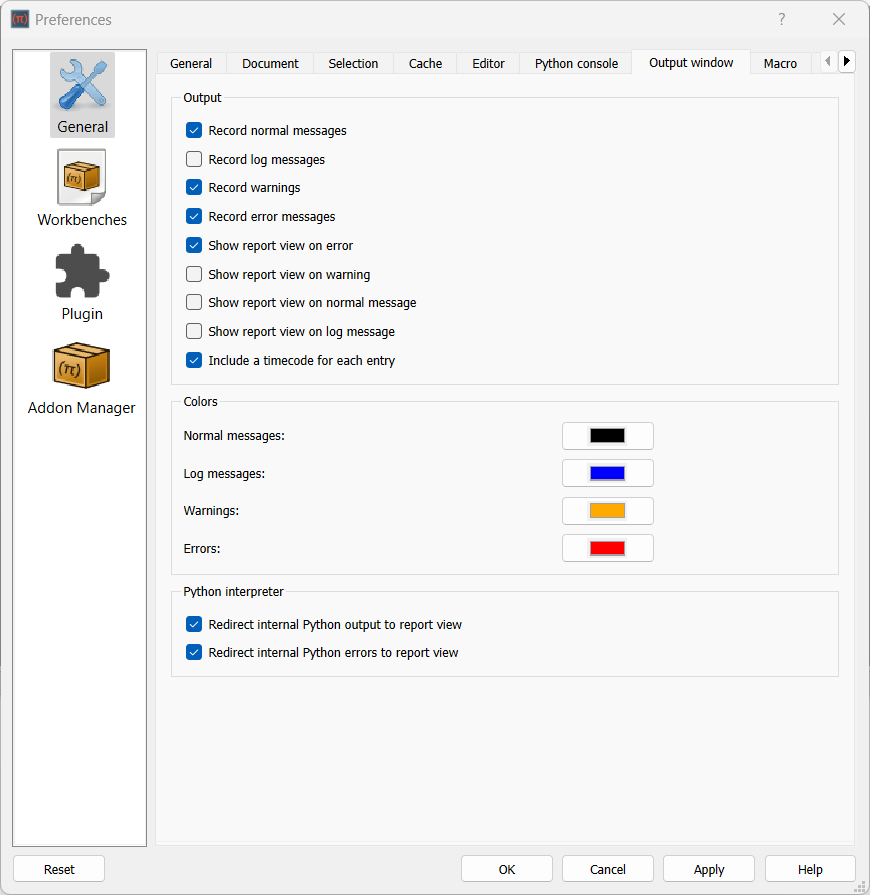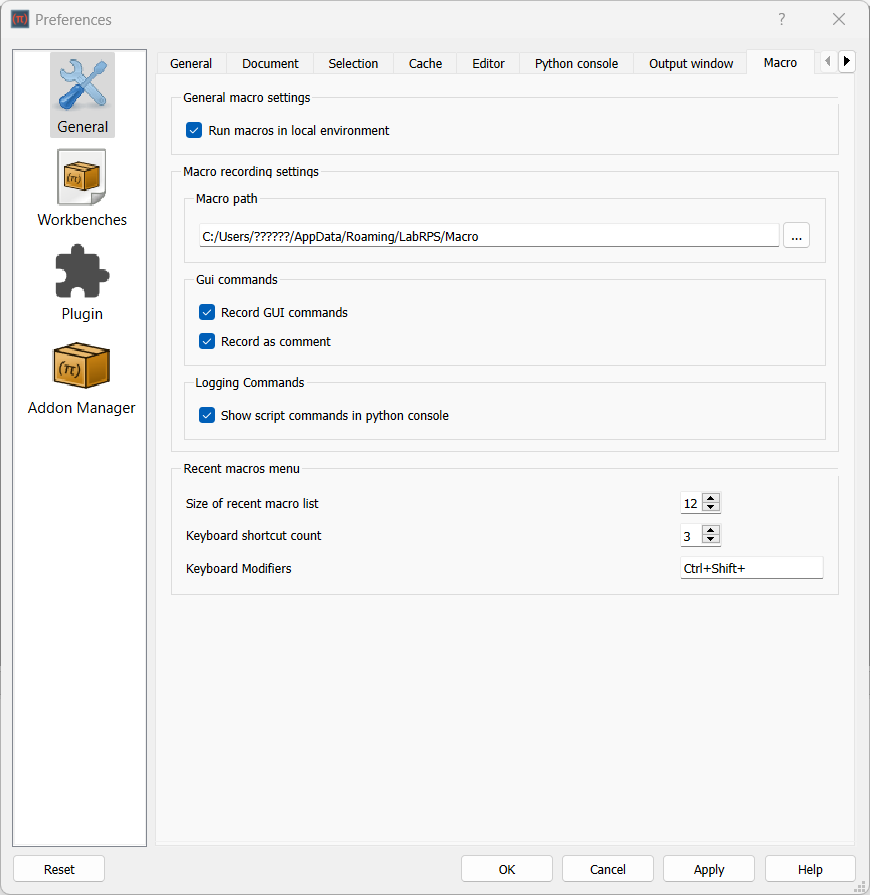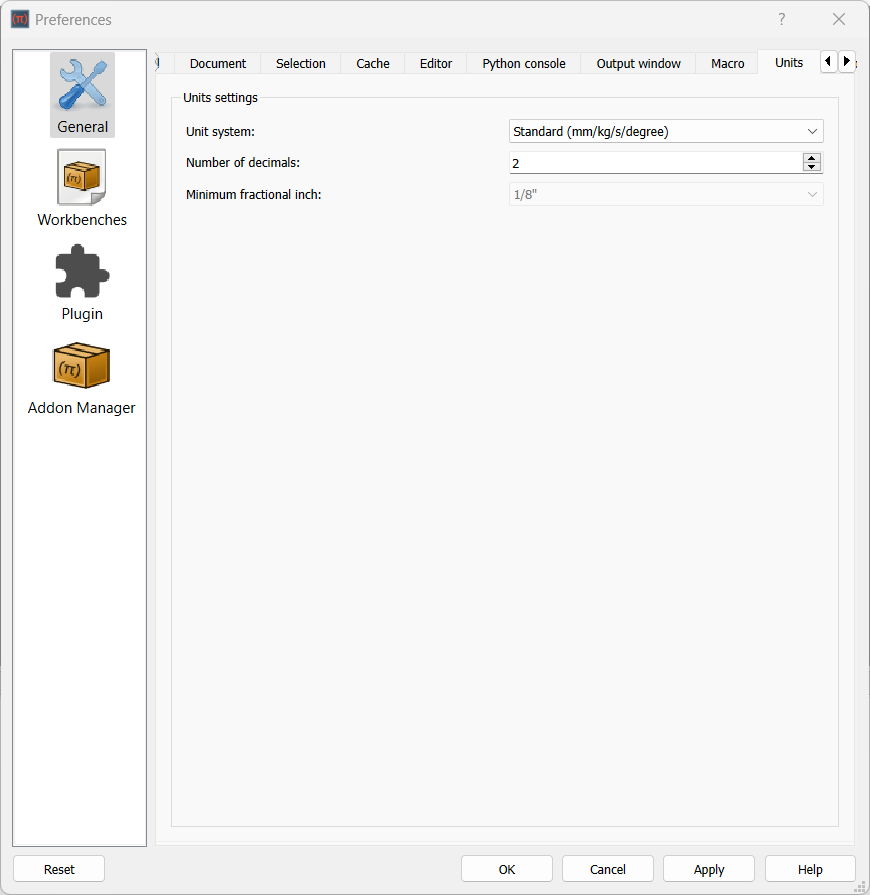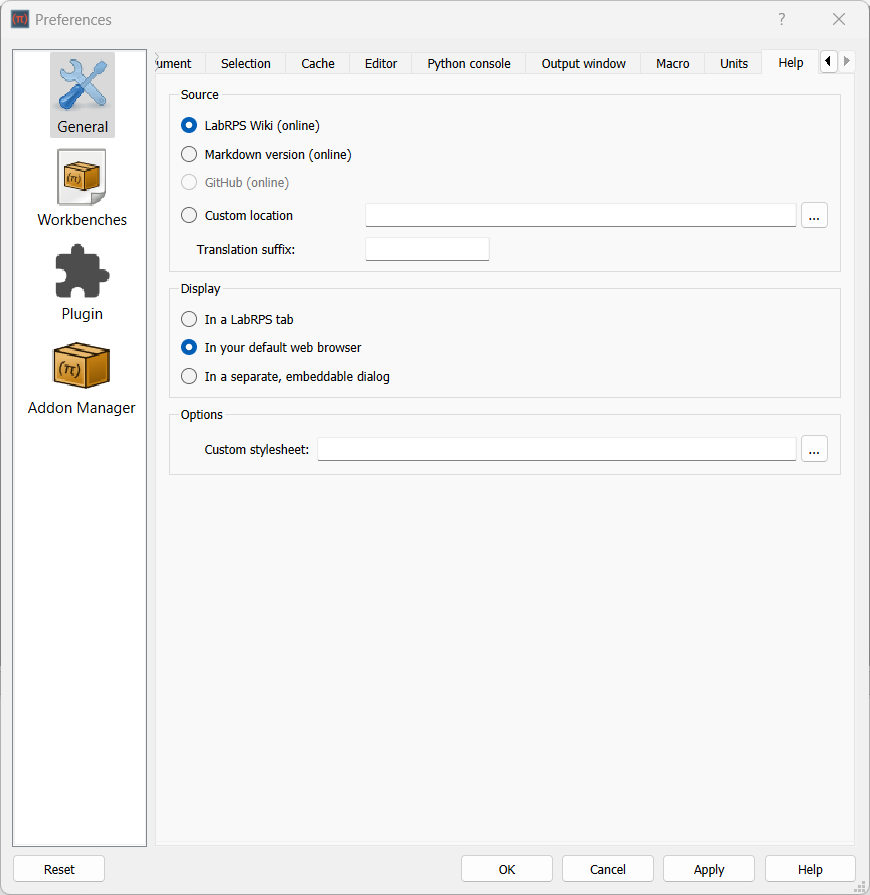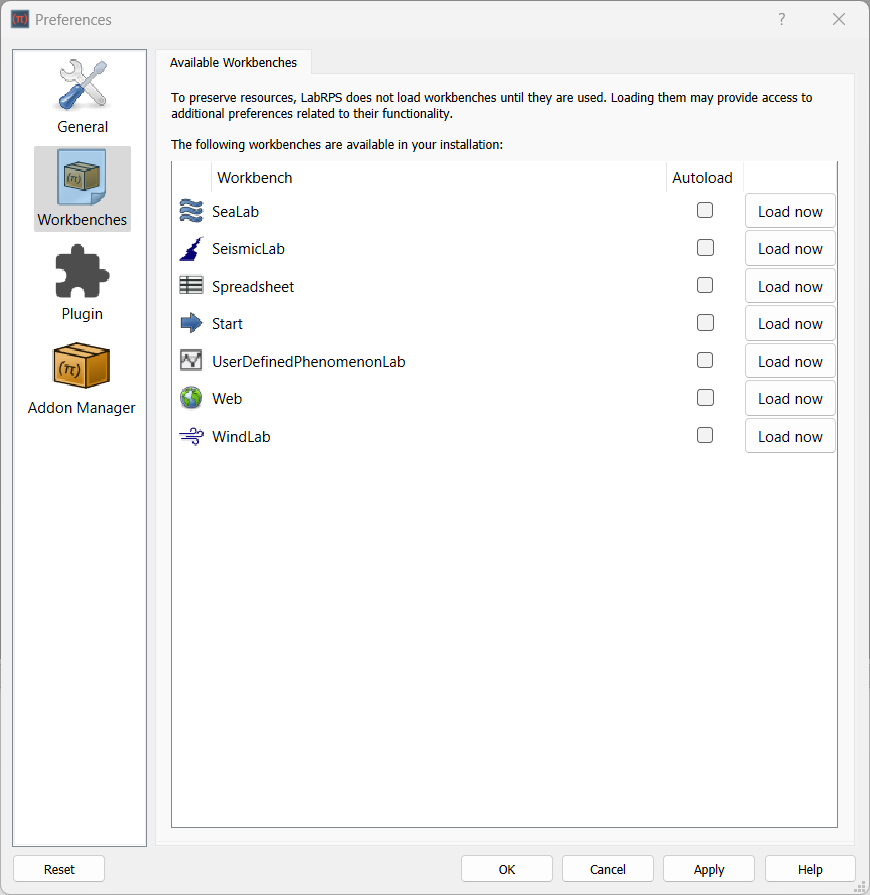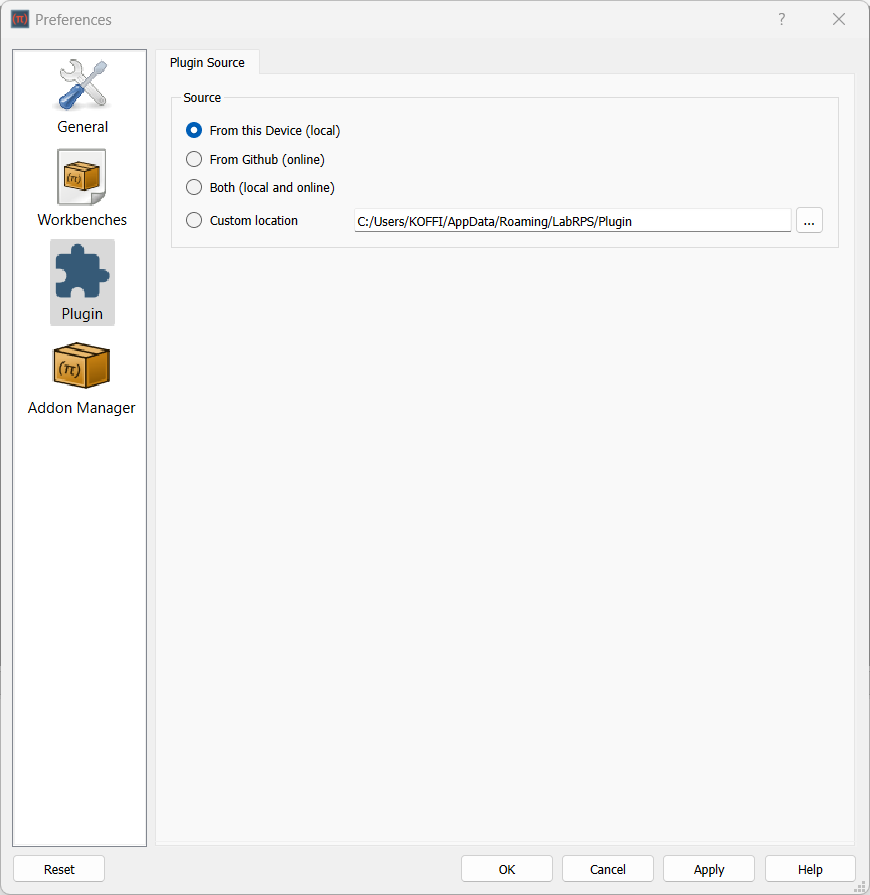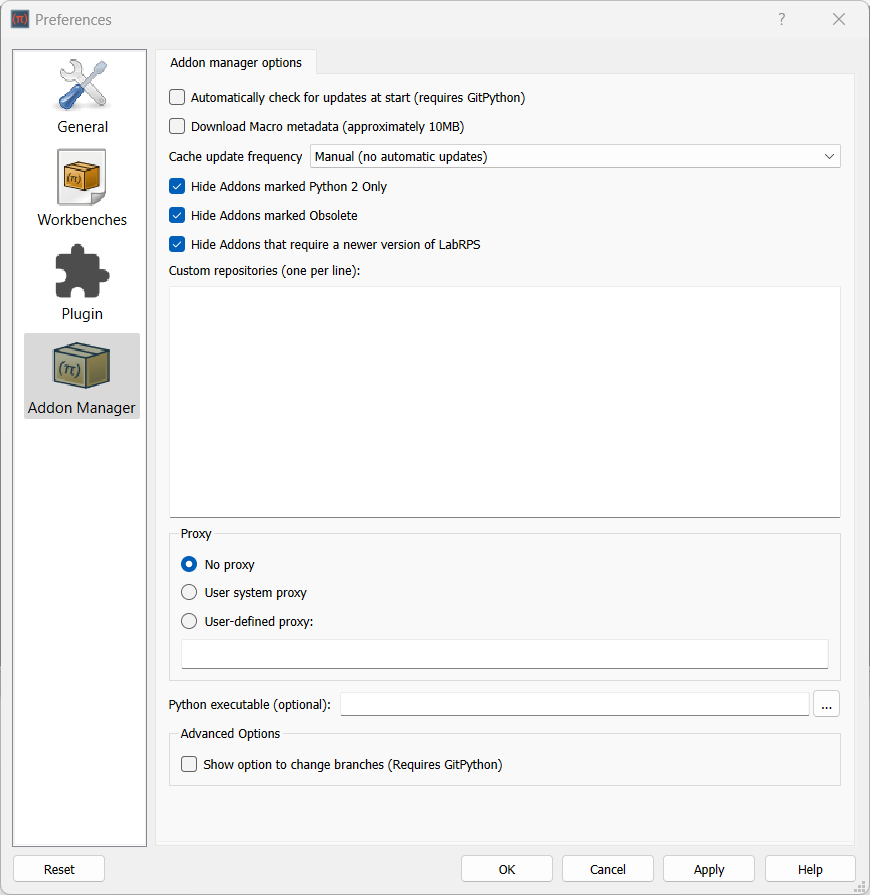Preferences Editor
Introduction
To start the Preferences editor select the Edit → Preferences... option from the menu. On the Mac OS the Preferences... option appears in the LabRPS menu instead (this is the default place for preferences on the Mac).
LabRPS uses a workbench concept, where each workbench is responsible for specific tasks and functions. A workbench can have its own preferences. These will only appear in the Preferences editor if the workbench has been loaded in the current LabRPS session. See Workbenches below for more information.
If no workbench is loaded, four sections appear in the Preferences editor: General, Workbenches, Plugins, and Addon Manager. Any workbenches that have been loaded, and have their own preferences, will appear below these.
Please note that pressing the Reset button in the lower left corner of the Preferences dialog will reset all LabRPS preferences to their default values.
Some advanced preferences can only be changed in the Parameter editor.
General settings
This preferences section has 10 tabs: General, Document, Selection, Cache, Editor, Python console, Output window, Macro, Units and help.
General
On the General tab you can specify the following:
| Name | Description |
|---|---|
| Change language | Selection of the language of the LabRPS user interface |
| Use selected language number format | If checked, the decimal separator of the selected language is used. Otherwise an English-like style (POSIX) will be used. |
| Substitute decimal separator | If checked, the numerical keypad decimal separator will be substituted with the locale's separator. Needs LabRPS to be restarted to take effect. |
| Preference packs | Lists the available preference packs and also allows you to save new packs. |
| Size of recent file list | Specification how many files should be listed in the recent files list. |
| Enable tiled background | If checked, the background of LabRPS's main window will by default consist of tiles of this image: File:Background.png
This option only has an effect if no Style sheet is selected. The image can be changed by adding the folders Gui/Images in the folder: %APPDATA%/LabRPS (on Windows), $HOME/.LabRPS (on Linux) or $HOME/Library/Preferences/LabRPS (on MacOS). Place a file named background.png in the Images folder, and uncheck/check this option to see the changed file. |
| Style sheet | Selection of a style sheet. Style sheets define how the user interface of LabRPS looks. For technical details about the style sheets, see themes. |
| Size of toolbar icons | Selection of the size for the toolbar icons |
| Tree view mode | Customization how the tree view is shown in the panel (restart required). The options are:
|
| Auto load module after start up | Selection what workbench will be used directly after starting LabRPS |
| Enable splash screen at start up | If checked, a splash screen is shown when starting LabRPS. |
Document
On the Document tab you can specify the following:
| Name | Description |
|---|---|
| Create new document at start up | If checked, LabRPS will create a new document when started |
| Document save compression level | Specification of the compression level for FCStd files. FCStd files are ZIP-compressed files. Therefore you can rename their suffix .FCStd to .zip and open them with a ZIP archive program. |
| Using Undo/Redo on documents | If checked, all changes in documents are stored so that they can be undone/redone |
| Maximum Undo/Redo steps | Specification how many Undo/Redo steps should be recorded |
| Allow aborting recomputation | If checked, recomputations can be aborted by pressing Esc. This may slightly increase the recomputation time. |
| Run AutoRecovery at startup | If there is a recovery file available LabRPS will automatically run a file recovery when it is started. This way files can be restored if a crash occurred. |
| Save AutoRecovery information every | Specification how often a recovery file is written. |
| Save thumbnail into project file when saving document | If checked, a thumbnail will be stored when the document is saved. The thumbnail will for example be shown in the list of recent files in the Start workbench. It is possible to select a Size between 128×128 and 512×512 pixels for the thumbnail. Common sizes are the powers of two: 128, 256, 512. |
| Add the program logo to the generated thumbnail | If checked, the LabRPS program logo |
| Maximum number of backup files to keep when resaving document | If checked, backup files will be kept when saving the document. You can specify the number of backup files to keep. Backup files are previously saved versions of the document. The first backup file will have the file suffix .FCStd1, the second .FCStd2 and so on. |
| Use date and FCBak extension | If checked, backup files will get the extension .FCbak and their file names get a date suffix according to the specified date format. For a description of the date format see this site.
With the default settings a backup file will for example get this name TD-Cube.20200315-215654.FCBak (original filename is TD-Cube.FCStd). |
| Allow duplicate object labels in one document | If checked, objects can have the same label. |
| Disable partial loading of external linked objects | If partial loading of external linked objects is enabled, only the referenced objects and their dependencies will be loaded when the linked document is auto opened together with the main document. Such a partially loaded document cannot be edited. Double click the document icon in the tree view to reload it in full. A more detailed explanation of this feature can be found on the Assembly3 documentation page |
| Author name | All created documents will get the specified author name. Keep the author field blank if you do not want to include this information. If the option Set on save is checked, the field Last modified by will be set to the specified author when saving the file. This field can be viewed using the File → Project information menu option. |
| Company | All created documents will get the specified company name |
| Default license | Selection of the license for new documents. For predefined licenses the License URL will automatically be set accordingly. Select Other for a custom license. |
| License URL | Specification of an URL describing the license selected in Default license |
Selection
On the Selection tab you can specify the following:
| Name | Description |
|---|---|
| Auto switch to the Dependency graph view containing the selected item | Enables the Tree view SyncView mode |
| Record selection in tree view in order to go back/forward using navigation button | Enables the Tree view RecordSelection mode |
| Add checkboxes for selection in document tree | Each document tree item will get a checkbox. This is for example useful for selecting multiple items on a touchscreen. |
Cache
These preferences are related to the cache directory where LabRPS stores temporary files.
On the Cache tab you can specify the following:
| Name | Description |
|---|---|
| Location | Specifies the path of the cache directory. |
| Check periodically at program start | Controls the frequency with which the directory size is checked. The options are:
|
| Cache size limit | Specifies the maximum size of the directory. You will be notified if a check is performed and the size exceeds this value. The options are:
|
| Current cache size | Shows the current size of the directory, if available. Press the Check now... button to update the value. |
Editor
The editor preferences settings affect the behavior of the macro editor. This editor can be opened using the menu Macro → Macros... → Edit/Create.
The color and font settings also affect the Python console. This console is shown using the menu View → Panels → Python console.
On the Editor tab you can specify the following:
| Name | Description |
|---|---|
| Enable line numbers | If checked, the code lines will be numbered |
| Enable block cursor | If checked, the cursor will have a block shape. |
| Tab size | Specification of the tabulator raster (how many spaces). If it is for example set to 6, pressing Tab will jump to character 7 or 13 or 19 etc., depending on the current cursor position. This setting is only used if Keep tabs is selected. |
| Indent size | Specification of how many spaces will be inserted when pressing Tab. This setting is only used if Insert spaces is selected. |
| Keep tabs | If selected, pressing Tab will insert a tabulator with the raster defined by Tab size |
| Insert spaces | If selected, pressing Tab will insert the amount of spaces defined by Indent size |
| Display Items | Selection of the code type. The color and font settings will be applied to the selected type. The result can be checked in the Preview field. |
| Family | Specification of the font family that should be used for the selected code type |
| Size | Specification of the font size that should be used for the selected code type |
| Color | Specification of the color that should be used for the selected code type |
Python console
These preferences control the behavior of the Python console. This console can be opened using the View → Panels → Python console menu option.
Note that the color and font settings for the console are defined on the Editor tab.
On the Python console tab you can specify the following:
| Name | Description |
|---|---|
| Enable word wrap | If checked, words will be wrapped if they exceed the available horizontal space in the console. |
| Enable block cursor | If checked, the cursor will have a block shape. |
| Save history | If checked, Python history is saved across sessions. |
Output window
The output preferences affect the behavior of the Report view. This panel is shown using the menu View → Panels → Report view.
On the Output tab you can specify the following:
| Name | Description |
|---|---|
| Record normal messages | If checked, normal messages will be recorded. They will be displayed in the Report view with the color set in Normal messages. |
| Record log messages | If checked, log messages will be recorded. They will be displayed in the Report view with the color set in Log messages. |
| Record warnings | If checked, warnings will be recorded. They will be displayed in the Report view with the color set in Warnings. |
| Record error messages | If checked, error messages will be recorded. They will be displayed in the Report view with the color set in Errors. |
| Show report view on error | If checked, the Report view will be shown automatically when an error is recorded |
| Show report view on warning | If checked, the Report view will be shown automatically when a warning is recorded |
| Show report view on normal message | If checked, the Report view will be shown automatically when a normal message is recorded |
| Show report view on log message | If checked, the Report view will be shown automatically when a log message is recorded |
| Include a timecode for each entry | If checked, each message and warning will receive a timecode |
| Normal messages | Specification of the font color for normal messages |
| Log messages | Specification of the font color for log messages |
| Warnings | Specification of the font color for warning messages |
| Errors | Specification of the font color for error messages |
| Redirect internal Python output to report view | If checked, internal Python output will be redirected from the Python console to the Report view |
| Redirect internal Python errors to report view | If checked, internal Python error messages will be redirected from the Python console to the Report view |
Macro
On the Macro tab you can specify the following:
| Name | Description |
|---|---|
| Run macros in local environment | If checked, variables defined by macros are created as local variables, otherwise as global Python variables |
| Macro path | Specification of the path for macro files |
| Record GUI commands | If checked, recorded macros will also contain user interface commands |
| Record as comment | If checked, recorded macros will also contain user interface commands, but as comments. This is useful if you don't want to execute these commands when running the macro, but do want to see what has been done while recording. |
| Show script commands in python console | If checked, the commands executed by macro scripts are shown in the Python console. This console is shown using the View → Panels → Python console menu option. |
| Size of recent macros list | Controls the number of recent macros to display in the menu |
| Shortcut count | Controls the number of recent macros that get dynamically assigned shortcuts |
| Keyboard Modifiers | Controls which keyboard modifiers are used for the shortcuts, example Ctrl+Shift+ creates shortcuts in the form of Ctrl+Shift+1, Ctrl+Shift+2, etc. |
Units
On the Units tab you can specify the following:
| Name | Description |
|---|---|
| Unit system | Selection of the unit system to be used for all parts of LabRPS |
| Number of decimals | The number of decimals that should be shown for numbers and dimensions |
| Minimum fractional inch | Minimum fractional inch that should be displayed. This setting is only available if the unit system Building US (ft-in/sqft/cuft) is used. |
Help
On the Help tab you can specify the following:
| Name | Description |
|---|---|
| Help location | Specifies the location of the Help files. The options are:
|
| Display | Specifies where the documentation should be displayed. The options are:
|
| Custom stylesheet | Specifies an optional custom stylesheet. Not used for the Wiki URL. |
Workbenches
This preferences section has a single tab: Available Workbenches.
Available Workbenches
To preserve resources, LabRPS does not automatically load all available workbenches. And only if a workbench has been loaded will its preferences, if any, appear in the Preferences editor.
The Available Workbenches tab displays a list of all installed workbenches. To load a workbench press its Load now button. If you check a workbench's Autoload checkbox it will autoload when LabRPS starts up. Loading more workbenches will make the startup slower, but switching between workbenches that have already been loaded is faster.
If a newly loaded workbench has dedicated preference they will appear in a new section in the Preferences editor. Some workbenches add support for additional import and export formats. If there are any related preferences they will appear on one or more new tabs in the Preferences editor.
Plugins
This preferences section has a single tab: Plugin Source.
Plugin Source
On the Plugin Source tab you can specify the location where plugin should be loaded from:
| Name | Description |
|---|---|
| From this device (local) | If selected, LabRPS will try to load plugins from local folder named plugins under the LabRPS folder. |
| From Github (onine) | If selected, LabRPS will try to LabRPS plugins located on github repository. |
| Both (local and online) | If selected, LabRPS will try to load plugins from both local folder and online github repository. |
| Custom location | If selected, LabRPS will try to LabRPS plugins from local folder specified by the user. |
Addon Manager
This preferences section has a single tab: Addon manager options.
Addon manager options
These preferences control the behavior of the Addon manager.
On the Addon manager options tab you can specify the following:
| Name | Description |
|---|---|
| Automatically check for updates at start (requires GitPython) | If checked, the Addon manager will check for updates when it is launched. GitPython and git must be installed for this to work. |
| Download Macro metadata (approximately 10MB) | If checked, macro metadata is downloaded for display in the Addon manager's main addon listing. This data is cached locally. |
| Cache update frequency | Controls the frequency with which the locally cached addon availability and metadata information is updated. The options are:
|
| Hide Addons marked Python 2 Only | If checked, addons marked as "Python 2 Only" are not included in the listing. These addons are unlikely to work in the current LabRPS version. |
| Hide Addons marked Obsolete | If checked, addons marked as "Obsolete" are not included in the listing. |
| Hide Addons that require a newer version of LabRPS | If checked, addons that require a newer LabRPS version are not included in the listing. |
| Custom repositories (one per line) | Custom repositories can be specified here. They should include the name of the branch you intend to use (typically "master" or "main"). |
| Proxy | The Addon manager includes experimental support for proxies requiring authentication, set up as user-defined proxies. |
| Python executable (optional) | The Addon manager attempts to determine the Python executable that should be used for the automatic pip-based installation of Python dependencies. To override this selection, the path to the executable can be set here. |
| Show option to change branches (requires GitPython) | For developers and beta-testers, the Addon manager can provide an interface on the addon's details screen that allows switching which git branch is currently checked out. This is intended for advanced users only, as it is possible that a non-primary-branch version of the Addon may result in instability and compatibility issues. GitPython must be installed for this to work. Use with caution. |
Related
- Getting started
- Installation: Download, Windows, Linux, Mac, Additional components, AppImage
- Basics: About LabRPS, Interface, RPS Objects, Object name, Preferences, Workbenches, Document structure, Properties, Help LabRPS, Donate
- Help: Tutorials, Video tutorials
- Workbenches: Std Base, WindLab, SeismicLab, SeaLab, UserLab, Spreadsheet, Plot, Web
- Hubs: User hub, Power users hub, Developer hub
